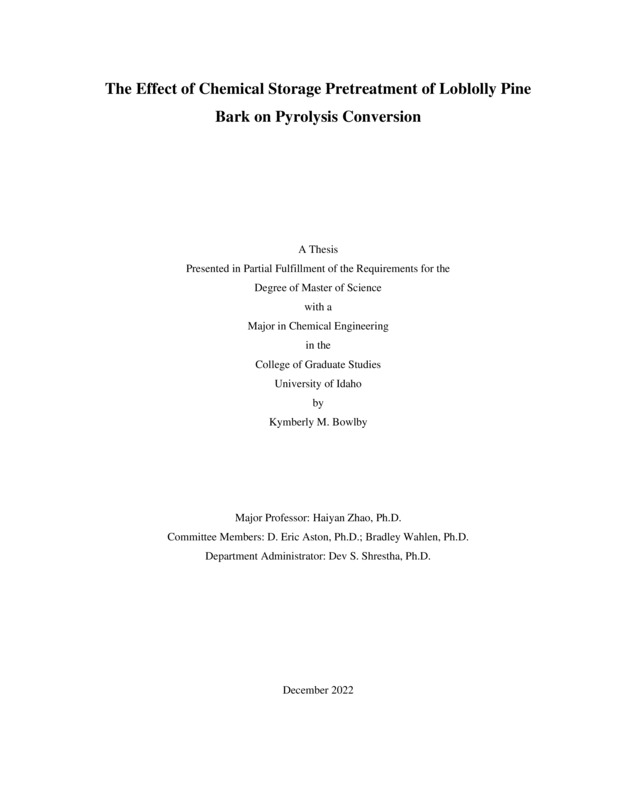The Effect of Chemical Storage Pretreatment on Loblolly Pine Bark Pyrolysis
Bowlby, Kymberly. (2022-12). The Effect of Chemical Storage Pretreatment on Loblolly Pine Bark Pyrolysis. Theses and Dissertations Collection, University of Idaho Library Digital Collections. https://www.lib.uidaho.edu/digital/etd/items/bowlby_idaho_0089n_12508.html
- Title:
- The Effect of Chemical Storage Pretreatment on Loblolly Pine Bark Pyrolysis
- Author:
- Bowlby, Kymberly
- Date:
- 2022-12
- Embargo Remove Date:
- 2023-07-24
- Keywords:
- Bark Biochar Pyrolysis Waste-to-energy
- Program:
- Chemical & Biological Engineering
- Subject Category:
- Chemical engineering
- Abstract:
-
Bark is an undervalued but abundant and low-cost biomass feedstock available for thermochemical conversion into liquid fuels and biochar. But bark has a high ash (inorganic) and lignin content, restricting the conversion efficiency. This thesis focuses on the use of anerobic storage with low severity chemicals on pine bark to increase pyrolysis conversion. Treatments of loblolly pine bark included acid (0.1% and 1% sulfuric acid, w/w dry basis) and alkali (4% sodium hydroxide, w/w dry basis). Pretreated bark was then incubated anaerobically for 1 and 2 weeks, simulating an in-pile treatment at a refinery gate. Bark was pyrolyzed at 500°C by a microwave assisted fast pyrolysis reactor. Sulfuric acid treatments reduced alkali and alkaline earth metals (AAEM) from the bark and showed an increase in oil production over the native bark. Although oil production was not statistically significant, significant compositional changes of the bark were observed and influenced the quality of the pyrolysis products. Biochar was further analyzed for potential in the agricultural sector as a soil amendment and carbon sequester. Key performance indicators for the use of biochar as a solid fuel were also analyzed by proximate composition, thermal recalcitrance, combustion and energy characteristics, pH, and electrical conductivity. The 1% sulfuric acid treatment showed great improvement in key performance indicators therefore it can be successful in both soil amendment and solid fuel applications. The alkaline treatment significantly decreased both oil conversion and the key performance indicators, thus it is not a satisfactory pretreatment for pyrolysis conversion. Furthermore, a lower cost chemical drying process utilizing dimethyl ether (DME), was explored for compositional changes, pyrolysis yields, and biochar potentials. The DME treatment did not significantly change the initial materials composition.
- Description:
- masters, M.S., Chemical & Biological Engineering -- University of Idaho - College of Graduate Studies, 2022-12
- Major Professor:
- Zhao, Haiyan
- Committee:
- Aston, D. Eric; Wahlen, Bradley; Shrestha, Dev
- Defense Date:
- 2022-12
- Identifier:
- Bowlby_idaho_0089N_12508
- Type:
- Text
- Format Original:
- Format:
- application/pdf
- Rights:
- In Copyright - Educational Use Permitted. For more information, please contact University of Idaho Library Special Collections and Archives Department at libspec@uidaho.edu.
- Standardized Rights:
- http://rightsstatements.org/vocab/InC-EDU/1.0/

